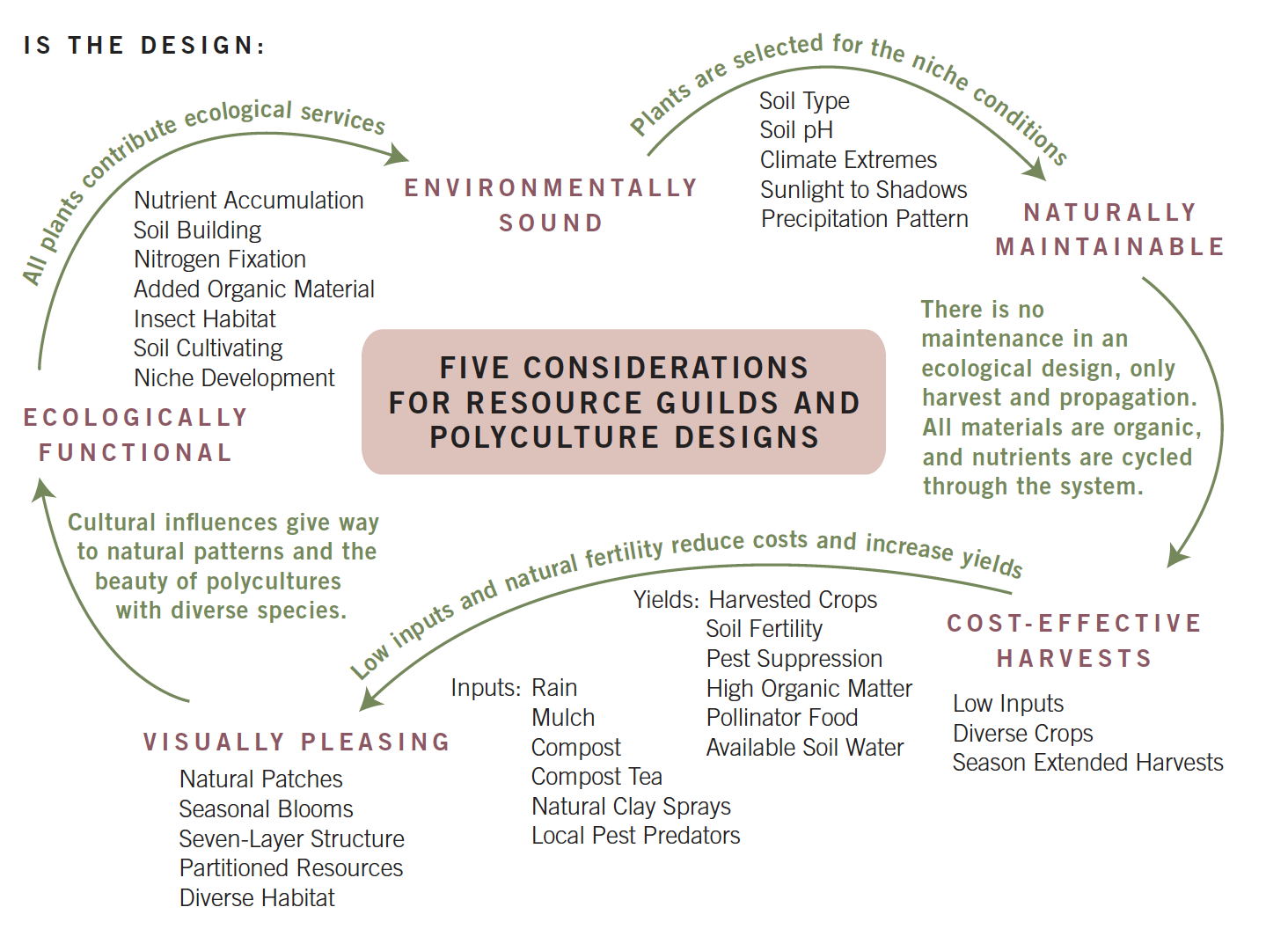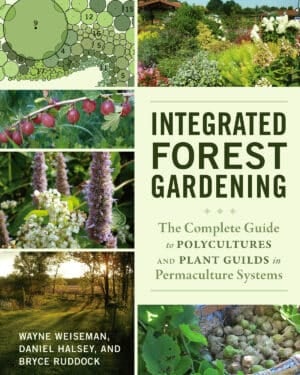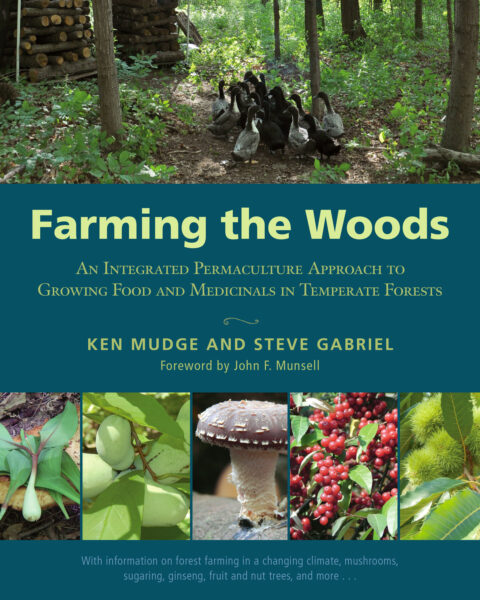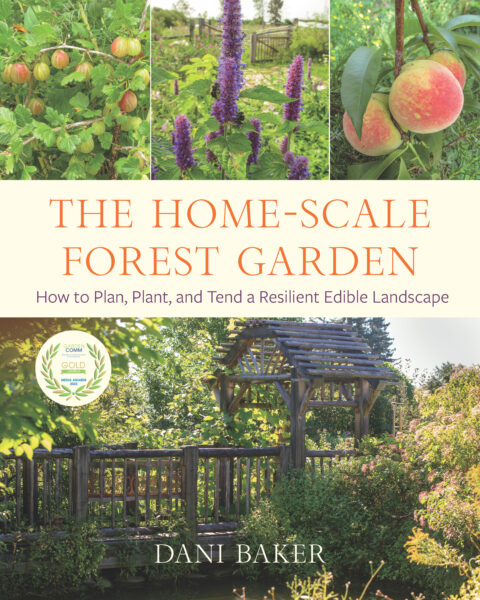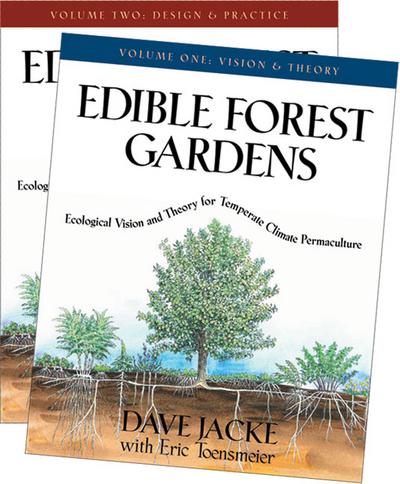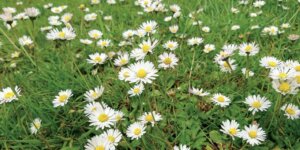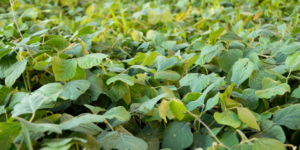What is a Plant Guild?
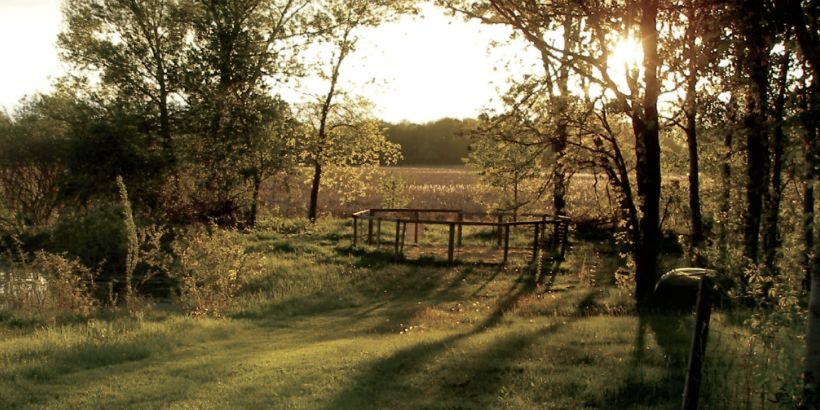
What does the term “plant guild” actually mean?
Technically, a plant guild is a beneficial grouping of plants that support humans, animals, and even one another. The key to creating a successful one is identifying the right design for your permaculture project.
The following is an excerpt from Integrated Forest Gardening by Daniel Halsey, Bryce Ruddock, and Wayne Weiseman. It has been adapted for the web.
A Plant Guild: What Is It?
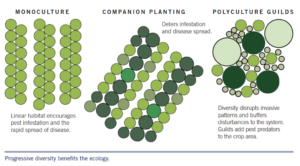 We frequently hear questions from Permaculture students and practitioners about plant guilds: how to configure them; why we select the plants we do; what functions the plants serve; why setting up particular relationships is beneficial to the guild; in other words: “How do you do it?”
We frequently hear questions from Permaculture students and practitioners about plant guilds: how to configure them; why we select the plants we do; what functions the plants serve; why setting up particular relationships is beneficial to the guild; in other words: “How do you do it?”
In Permaculture systems the plant guild is central to developing a diverse integrated forest garden. A permanent agriculture is an agriculture based on the planting of perennials.
Perennial plant guilds are the foundation from which we begin. Think of an integrated forest garden as an assembly of plant guilds working together in functional relationship.
Definition of Plant Guild
A plant guild, put succinctly, is a beneficial grouping of plants that support one another in all their many functions: exchange of nutrients, water, and gases; physical buttressing; promoting diversification and redundancy in the system. Plant guilds also support animals and humans for all their food, medicine, and utility needs.
Toby Hemenway, author of Gaia’s Garden, the influential 2009 book on home-scale Permaculture, says it nicely:
“Guilds are an attempt to bridge the broad gap between conventional vegetable gardens and wildlife gardening by creating plant communities that act and feel like natural landscapes, but that include humans in their webwork. Vegetable gardens benefit only humans, while wildlife or natural gardens specifically exclude people from their ecological patterns. Ecological gardens…help our developed land to blossom into nourishing places for both humans and wildlife.”
Functions Of A Plant Guild
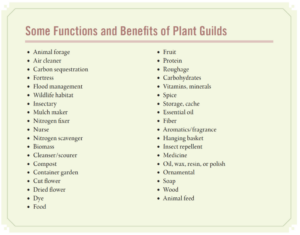 Clearly stated, there are no cookie-cutter guilds. What there is, is a scaffold, a structure, a set of diverse and multifarious functions that, when configured together, benefit groupings of plants that would not necessarily be there should these plants be growing in isolation.
Clearly stated, there are no cookie-cutter guilds. What there is, is a scaffold, a structure, a set of diverse and multifarious functions that, when configured together, benefit groupings of plants that would not necessarily be there should these plants be growing in isolation.
Functions such as nitrogen fixation, mineral and nutrient uptake and dispersal among the plants in the guild, the attraction of beneficial insects and pollinators, the filling of all niches from the soil profile to the canopy, and utility for animals and humans are how we define the structure of the plant guild.
We can then select plants that deliver what we need. A plant guild is about shared functions. In essence, we are designing for these shared functions first. This is how the relationships that we need for optimum health and production in the plant guild come about.
History of the Plant Guild
The concept of a guild is old and did not originally refer to plants. Members of medieval craft guilds performed a variety of important functions in the local economy. They established a monopoly of trade in their locality or within a particular branch of industry or commerce. They set and maintained standards for the quality of goods and the integrity of trading practices in that industry. They worked to maintain stable prices for their goods and commodities, and they sought to control town or city governments in order to further the interests of guild members and achieve their economic objectives.
The merchants and members of the craft guild worked together. This is what gave them the strength and perseverance to succeed. It is not difficult to apply this same idea to the plant guild: plants working together for the benefit of all. As stated in the American Heritage Dictionary, a biological guild is a group of organisms that use the same ecological resource in a similar way. In a plant guild the organisms are the plants and fauna, though many other resources come into play.
What Does the Word “Guild” Mean?
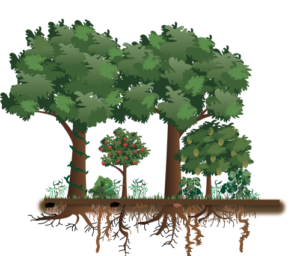 Bill Mollison, the creator of the Permaculture concept, initiated the use of the word guild. How did he decide on this word? Of course, this is only conjecture on our part, but craft guilds were occupational associations.
Bill Mollison, the creator of the Permaculture concept, initiated the use of the word guild. How did he decide on this word? Of course, this is only conjecture on our part, but craft guilds were occupational associations.
In the same way, plant guilds can be considered occupational associations, providing each plant in the guild support, focus in the landscape, and the means to persist as a community.
Plant Guilds: The Relationships Between Plants
In essence, plant guilds are not about the particular plants themselves; they’re about the relationships among plants, and the biological processes, chemical processes, and shared functions that actively circulate among the plants selected. You don’t have to be a horticulturalist to create a guild, though a basic understanding of plant functions goes a long way.
The Importance of Nitrogen
For example, nitrogen is what gives plants a kick start of growth in the spring. This very active element, found free ranging primarily in the atmosphere, is what greens up our spring fields and forests.
In a plant guild nitrogen-fixing plants (plants that sop up free-ranging nitrogen from the atmosphere and infuse it through the root zone into plants) are required in order to store this element and supply it to all other plants to initiate the spring growth process. Legumes are prime examples of nitrogen-fixing plants: clovers, beans and peas, black locust trees. The alder tree, a non-legume, is a major nitrogen fixer, and is especially beneficial in a plant guild as a fast-growing tree species.
Plant Guild Functions to Note
Another important function in a guild is the dynamic accumulator. Such a plant mines nutrients from different layers of the soil profile and brings them to the surface, where it drops them for other plants in the guild to ingest.
Plants such as comfrey, dandelion, and other taprooted species are very efficient at doing just this. The dandelion absorbs calcium, iron, magnesium, phosphorus, potassium, sodium, zinc, copper, and selenium through its taproot and supplies other plants as its leaves die back and drop to the surface of the soil. There the soil biology, animals and fungi, break the leaves down and make their nutrients available for other plants.
Guilds: Coexisting in Harmony
Guilds or associations of living organisms are groupings of species that coexist in an environment, sharing resources or acting as resources for one another. Sometimes these relationships work to the benefit of the entire system and sometimes not. But whether an ecosystem is in balance is not readily apparent to the human observer.
Often overall balance and shared functional relationships in a plant guild manifest over a length of time spanning years or even generations. This is probably one of the reasons that Bill Mollison recommends getting a good chair and sitting down with a notebook and pencil to record these relationships, spatial, temporal, and otherwise.
Recommended Reads
Recent Articles
Want to see your crops thrive this upcoming growing season? The key is in soil fertility and health. Spend time maintaining your soil’s health to guarantee bigger and better crops come harvest time! The following is an excerpt from No-Till Intensive Vegetable Culture by Bryan O’Hara. It has been adapted for the web. What Is Soil Fertility?…
Read MoreMany know the effects of catnip on our feline friends, but few realize that catnip has medicinal effects for humans. From stomach aches to reducing fevers, catnip is a versatile herb with many benefits. The next time you grow this plant for your cat you may end up taking a few cuttings for yourself! The…
Read MoreIt’s time to take control of your seeds and become a plant breeder! Saving your seed allows you to grow and best traditional & regional varieties, and develop more of your own. The following excerpt is from Breed Your Own Vegetable Varieties by Carol Deppe. It has been adapted for the web. Becoming A Plant…
Read MoreRewilding is one of the best things you can do for the biodiversity of your farm or garden. By no longer mowing your lawn, flowers will start to grow, creating a meadow and a habitat for creatures that often get forgotten. The following is an excerpt from The Healthy Vegetable Garden by Sally Morgan. It…
Read MoreTrying to figure out how to manage weeds in your garden beds? Use cover crops and living mulches for weed suppression while your garden flourishes! The following is an excerpt from The Ecological Farm by Helen Atthowe. It has been adapted for the web. Suppressing Weeds With Cover Crops: Getting Started Cover crops suppress weeds…
Read More

